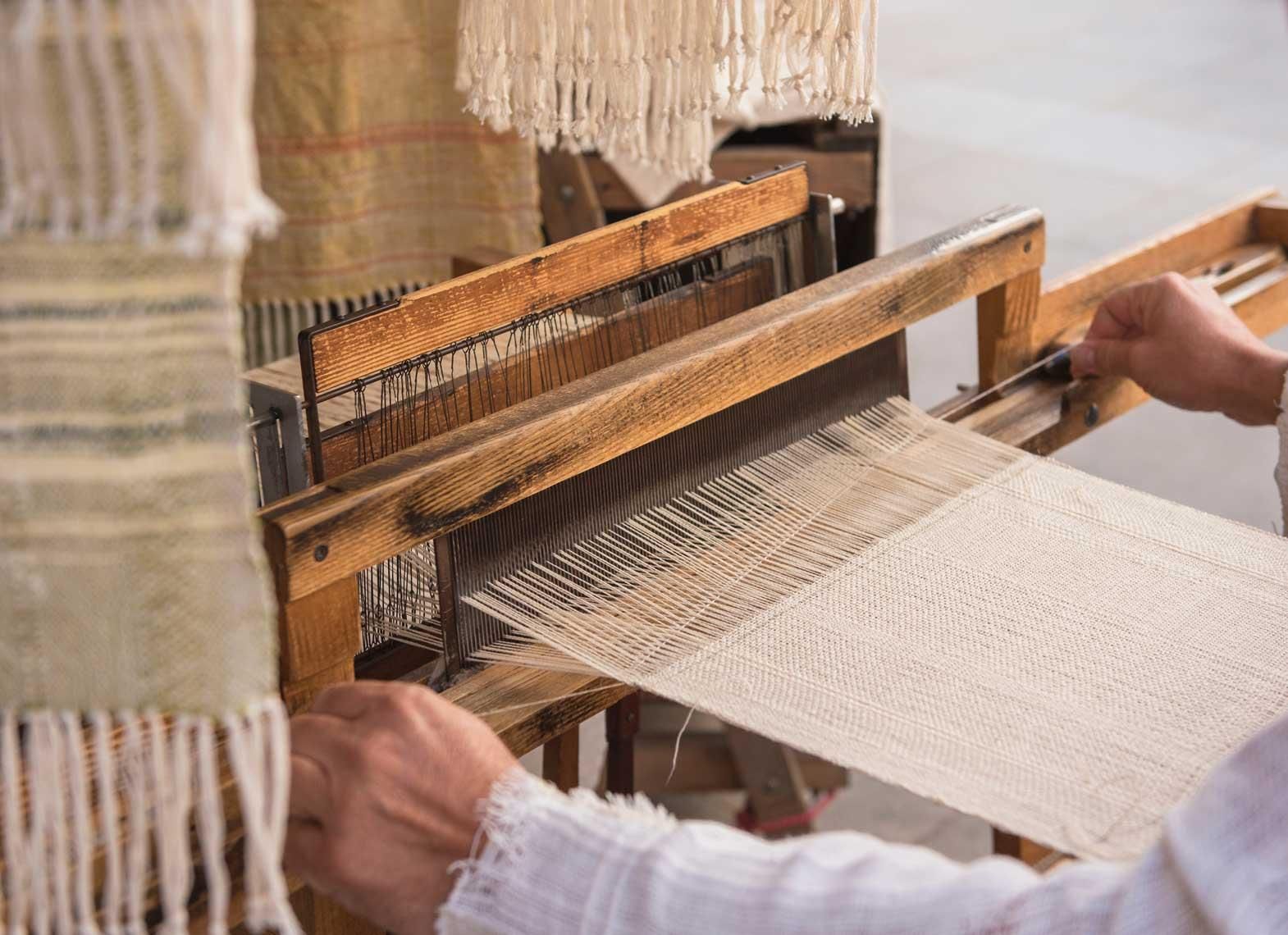Fieldtrials observing the use of woven ropes show encouraging performance, say
Woven ropes are strongercompared to braided, conventional ropes. The Ahmedabad Textile Industry's ResearchAssociation (ATIRA) developed woven ropes with core and sheath arrangements.Comparison was carried out with the same type of braided ropes in terms ofmaterial and diameter. In this way we can get the strength of the core yarn.For example, aramid fibres can be covered with polyester to use in the marineindustry. Glass fibre can be covered with cotton for aesthetic propertiesduring handling.
The developmentalactivities carried out in the area of high strength ropes using varieties ofhigh tenacity yarns were carried out to:
1.
2.
3.
4.
Manufacturingwoven ropes at ATIRA Incubation Centre
Weaving rope withcore-sheath structure of pre-decided design using varieties of yarn:
a)
b)
c)
d)
e)
f)
g)
Manufacturing braided ropes
* Making ropes by conventional braiding process entails:
a) Creeling of yarn as per plan on Susmatex Braiding Machine
b) To insert individual ends in needles
c) To adjust settings
d) Complete the braiding
Comparison of woven and braided ropes: Set 01
|
SAMPLE No. |
MATERIAL |
DESCRIPTION |
TENSILE STRENGTH (KN) |
ELON GATION% |
ROPE DIA (MM) Actual |
OBSERVATION |
|
01 |
Glass Fibre-2 ply as Core / Polyester as Sheath |
Woven Rope with 40 ends in core and approx. 9 mm dia |
9.269 |
4.78% |
8.9 |
Woven rope has significantly more tensile strength and elongation properties compared to braided rope |
|
02 |
Glass Fibre-2 ply as Core / Polyester as Sheath |
Braided Rope with 40 ends in core and approx. 9 mm dia |
1.795 |
1.65% |
8.7 |
Comparison of woven and braided ropes: Set 02
|
SAMPLE No. |
MATERIAL |
DESCRIPTION |
TENSILE STRENGTH (KN) |
ELONGATION% |
ROPE DIA (MM) Actual |
OBSERVATION |
|
03 |
Aramid as Core / Polyester as Sheath |
Woven Rope with 56 ends in core and approx.9 mm dia |
4.1 |
35.61% |
9.1 |
Woven rope has significantly more tensile strength and elongation properties compared to braided rope |
|
04 |
Aramid as Core / Polyester as Sheath |
Braided Rope with 56 ends in core and approx. 9 mm dia |
3.2 |
24.21% |
9.1 |
|
SAMPLE No. |
MATERIAL |
DESCRIPTION |
TENSILE STRENGTH (KN) |
ELONGATION% |
ROPE DIA (MM) Actual |
OBSERVATION |
|
05 |
50 K Carbon as Core & 3000 Denier Polyester as Sheath |
Woven Rope with 12 ends in core and approx. 9 mm dia |
6.31 |
27.59% |
9.3 |
Woven Rope has significantly more Tensile Strength. |
|
06 |
50 K Carbon as Core & 3000 Denier Polyester as Sheath |
Braided Rope with 12 ends in core and approx. 9 mm dia |
2.55 |
33.18% |
9.0 |
Comparison of woven and braided ropes: set 04
|
SAMPLE No. |
MATERIAL |
DESCRIPTION |
TENSILE STRENGTH (KN) |
ELONGATION% |
ROPE DIA (MM) Actual |
OBSERVATION |
|
07 |
50 K Carbon & 100 % jute on sheath |
Woven rope with 12 ends in core and approx. 9 mm dia |
10.8 |
1.08% |
9.0 |
Woven rope has very high tensile strength |
|
08 |
50 K Carbon & 100 % Jute on sheath |
Braided Rope with 12 ends in core and approx. 9 mm dia |
2.4 |
2.66% |
8.6 |
Comparison of woven and braided ropes: Set - 05
|
SAMPLE No. |
MATERIAL |
DESCRIPTION |
TENSILE STRENGTH (KN) |
ELONGATION% |
ROPE DIA (MM) Actual |
OBSERVATION | ||
|
09 |
woven rope with 4s/10 ply Aramid(Core) & 1000 Denier Polyester (Sheath) |
10 ends in core , 43 ends in sheath |
2.99 |
48.68% |
9.4 |
Woven rope has significantly more tensile strength compared to braided rope | ||
|
09 |
woven rope with 4s/10 ply Aramid(Core) & 1000 Denier Polyester (Sheath) |
10 ends in core , 43 ends in sheath |
2.99 |
48.68% |
9.4 |
Woven rope has significantly more tensile strength compared to braided rope |
|
10 |
Braided rope with 4s/10 ply Aramid(Core) & 1000 Denier Polyester (Sheath) |
10 ends in core , 43 ends in sheath |
� 2.08 |
66.00% |
9.5 |
Comparison of woven and braided ropes: Set - 06
|
SAMPLE No. |
MATERIAL |
DESCRIPTION |
TENSILE STRENGTH (KN) |
ELONGATION% |
ROPE DIA (MM) Actual |
OBSERVATION |
|
11 |
woven rope with 4s/10 ply Aramid (Core) & 6s / 5 Ply PC (Sheath) |
10 ends in core , 43 ends in sheath |
1.91 |
38.83% |
8.6 |
Woven rope has significantly more tensile strength compared to braided rope |
|
12 |
Braided rope with 4s/10 ply Aramid (Core) & 6s / 5 Ply PC (Sheath) |
10 ends in core , 43 ends in sheath |
1.23 |
38.37% |
8.4 |
Comparison of woven and braided ropes: Set 07
|
SAMPLE No. |
MATERIAL |
DESCRIPTION |
TENSILE STRENGTH (KN) |
ELONGATION% |
ROPE DIA (MM) Actual |
OBSERVATION |
|
SAMPLE No. |
MATERIAL |
DESCRIPTION |
TENSILE STRENGTH (KN) |
ELONGATION% |
ROPE DIA (MM) Actual |
OBSERVATION |
|
13 |
Woven rope 1000 Denier Polyester (White)Core & 2000 Denier Polyester (Blue) Sheath |
10 Core ends, 52 sheath ends |
3.01 |
43.13% |
11.8 |
Woven rope has significantly more tensile strength compared to braided rope |
Comparison of woven and braided ropes: Set - 08
|
SAMPLE No. |
MATERIAL |
DESCRIPTION |
TENSILE STRENGTH (KN) |
ELONGATION% |
ROPE DIA (MM) Actual |
OBSERVATION |
|
14 |
woven rope with Dyneema core/ Polyester Sheath |
2000 Denier Polyester & 1750 Denier Dyneema yarn |
4.861 |
11.98% |
6.2 |
Woven rope has significantly more tensile strength compared to braided rope |
|
15 |
Braided rope with Dyneema Core/ Polyester Sheath |
2000 Denier Polyester & 1750 Denier Dyneema yarn |
2.45 |
25.75% |
6.3 |
Analysis of results:
In every case, woven ropes are stronger (average tensile strength approximately 7.24 KN) compared to braided ropes (average tensile strength approximately 2.46 KN) indicating superior performance of woven ropes.
Woven ropes with required properties as that of braided ropes would be approximately at least 30 per cent lighter.
Due to core and sheath arrangement of yarn in woven ropes, they are more comfortable and more aesthetic in practical use.
Plans to utilise the equipment facilities in future
Indian Railways for luggage handling
A porter using woven rope to tie luggage on the trolley at Ahmedabad Railway Station found woven rope much more comfortable over traditional HDPE packing strips. It also had better handling comfort and strength
Experiments at ATIRA
During trial to assess the strength of woven rope, we have seen that only two woven ropes with same diameter and material are sufficient as against a number of non-woven ropes required to carry the same weight.
We can weave a variety of cost-effective samples on narrow looms with limited consumption of expensive yarn. This technology is important to produce specified application products like high strength ropes. Investment in narrow machines for ropes will give confidence to owner of a self-employed business.








Comments